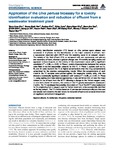Application of the Ulva pertusa bioassay for a toxicity identification evaluation and reduction of effluent from a wastewater treatment plant
| dc.contributor.author | Kim, YJ | en |
| dc.contributor.author | Han, YS | en |
| dc.contributor.author | Kim, E | en |
| dc.contributor.author | Jung, J | en |
| dc.contributor.author | Kim, SH | en |
| dc.contributor.author | Yoo, SJ | en |
| dc.contributor.author | Shin, GS | en |
| dc.contributor.author | Oh, JJ | en |
| dc.contributor.author | Park, A | en |
| dc.contributor.author | Choi, H | en |
| dc.contributor.author | Kim, MS | en |
| dc.contributor.author | Brown, MT | en |
| dc.contributor.author | Han, T | en |
| dc.date.accessioned | 2015-12-10T14:22:02Z | |
| dc.date.available | 2015-12-10T14:22:02Z | |
| dc.date.issued | 2015-03-03 | en |
| dc.identifier.uri | http://hdl.handle.net/10026.1/3925 | |
| dc.description.abstract |
A toxicity identification evaluation (TIE) based on Ulva pertusa spore release was conducted in 3 phases for the identification of the major toxicants in effluent from a wastewater treatment plant (WTP) and the receiving water in an adjacent stream. The toxicity of the final effluent (FE), as compared with raw wastewater, and primary and secondary effluent, showed a greater change over 12-monthly sampling events and appeared to have impacts on the toxicity of the downstream water with a significant correlation (r 2 = 0.89, p < 0.01). In Phase I, toxicity characterization indicated that cations were likely to be the responsible toxicants for the FE. In Phase II, cations such as Cu, Ni, and Zn were found in the FE at higher concentrations than the EC 50 concentrations determined for the standard corresponding metals. When the concentrations of each metal in the FE samples were plotted against the respective toxicity units, only zinc showed a statistically significant correlation with toxicity (r 2 = 0.86, p < 0.01). In Phase III, using spiking and mass balance approaches, it was confirmed that Zn was the major toxicant in the effluent from the WTP. Following a change in the Fenton reagent used, to one with a lower Zn content, the toxicity of the FE greatly decreased in subsequent months. The TIE developed here enabled the toxicity of FEs of the WTP to be tracked and for Zn, originating from a reagent used for Fenton treatment, to be successfully identified as the key toxicant. The TIE method based on U. pertusa demonstrated utility as a low cost and simple tool to identify the risk factors for industrial effluents and provided information on regulatory control and management. | en |
| dc.language.iso | en | en |
| dc.title | Application of the Ulva pertusa bioassay for a toxicity identification evaluation and reduction of effluent from a wastewater treatment plant | en |
| dc.type | Journal Article | |
| plymouth.issue | MAR | en |
| plymouth.volume | 3 | en |
| plymouth.publication-status | Published | en |
| plymouth.journal | Frontiers in Environmental Science | en |
| dc.identifier.doi | 10.3389/fenvs.2015.00002 | en |
| plymouth.organisational-group | /Plymouth | |
| plymouth.organisational-group | /Plymouth/Faculty of Science and Engineering | |
| plymouth.organisational-group | /Plymouth/REF 2021 Researchers by UoA | |
| plymouth.organisational-group | /Plymouth/REF 2021 Researchers by UoA/UoA06 Agriculture, Veterinary and Food Science | |
| plymouth.organisational-group | /Plymouth/Research Groups | |
| plymouth.organisational-group | /Plymouth/Research Groups/Marine Institute | |
| dc.identifier.eissn | 2296-665X | en |
| dc.rights.embargoperiod | Not known | en |
| rioxxterms.versionofrecord | 10.3389/fenvs.2015.00002 | en |
| rioxxterms.licenseref.uri | http://www.rioxx.net/licenses/all-rights-reserved | en |
| rioxxterms.type | Journal Article/Review | en |


